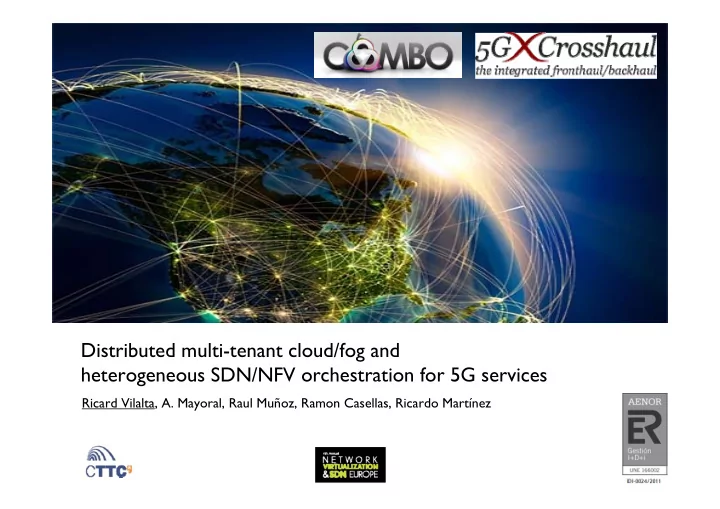

Distributed multi-tenant cloud/fog and heterogeneous SDN/NFV orchestration for 5G services Ricard Vilalta, A. Mayoral, Raul Muñoz, Ramon Casellas, Ricardo Martínez
The need for generic control functions and a Transport API The NBI of the domain controllers are typically technology and vendor dependent. The multi-domain SDN orchestrator shall implement different plugins for each of the controller’s NBI. The ONF Transport API defines a generic functional model of a control plane that can be used regardless of a particular vendor, and defines the associated protocol. Multi-domain SDN controller Transport API (T-API) MAN Controller WAN Controller MAN Controller (SDN) (GMPLS/PCE) (SDN) OF 1.3 OF 1.3 OF 1.3 OF 1.0 OF 1.0 OF 1.0 MAN WAN MAN (Packet Transport (e.g. WDM/Flexi-grid) (Packet Transport Network) Network) 2
ONF Transport API Overview Objective – realize the software-centric approach Topology Service to standardization Retrieve Topology, Node, Link & Edge-Point Purpose-specific API to facilitate SDN details control of Transport networks Connectivity Service Focus is on functional aspects of transport network control/mgmt Retrieve & Request P2P, P2MP, MP2MP connectivity Target is YANG & JSON API libraries Across (L0/L1/L2) layers Demonstrable code Path Computation Service Activity scoped based on use case contributions Request for Computation & Optimization of and discussions. Examples include paths Bandwidth on Demand Virtual network Service E2E Connectivity Service Create, Update, Delete Virtual Network Multi-layer Resource Optimization and topologies Restoration Notification Framework Multi-Domain Topology and Monitoring Subscription and filtering Network Slicing and Virtualization Autonomous mechanism 3
Multi-domain SDN controller for handling network complexity Architecture includes: Multi-domain SDN controller PCE Topology Manager Provisioning Manager VNTM Flow Server OAM Handler Abstraction Manager Cognition Policer 4
T-API enables integration of heterogeneous wireless and transport networks 5G services requires the integration of all network segments (radio/fixed access, metro and core) with heterogeneous wireless and optical technologies. T-API enables the integration of multiple Radio Access Technologies (RAT) with heterogeneous control planes and technologies (5G, mmWave, LTE/LTE-A, Wi-Fi, etc.) E2E Network Controller T-API T-API T-API T-API WAN RAT1 RAT2 MAN Controller Controller controller Controller RAT2 RAT1 Metro Access/Aggregattion Core Transport Network Network 5
Hierarchical SDN Control using T-API We have proposed a hierarchical control approach with different levels of hierarchy (parent/child architecture) for scalability, modularity, and security purposes in multi-technology multi-domain heterogeneous wireless/optical networks Each successively higher level has the potential for greater abstraction and broader scope, and each level may exist in a different trust domain. T-API can be used as the NBI of the child SDN controller and as SouthBound Interface (SBI) of a parent SDN controller in order to provision E2E services E2E Network Controller T-API T-API Wireless Network Controller Transport Network Controller T-API T-API T-API T-API WAN RAT1 RAT2 MAN Controller Controller controller Controller RAT2 RAT1 Metro Access/Aggregattion Core Transport Network Network 6
Peer SDN Control using T-API In a multi-carrier scenario there's no hierarchy, no cross-domain control, no cross-domain visibility. It is reasonable that a peer interconnection model is needed. The Peer SDN model corresponds to a set of controllers, interconnected in an arbitrary mesh, which cooperate to provision end-to-end services. The controllers hide the internal control technology and synchronize state using East/West interfaces. T-API can be used as the East/West interface. T-API T-API Wireless Network Transport Network Controller Controller T-API T-API WAN RAT1 RAT2 MAN Controller Controller controller Controller Wireless Network Controller RAT2 RAT1 RAT2 Transport Network Controller controller Controller WAN MAN RAT1 Controller Controller Metro Access/Aggregattion Core Transport Network Network 7
T-API enables global orchestration of cloud and network resources A Global orchestrator acts as a unified cloud and network operating system enabling the dynamic management of the virtual cloud and network resources allocated to the specific tenants (slices) T-API is a key enabler for the integration of cloud and network resources Global cloud and network orchestrator Virtual network T-API Virtual computing resources E2E Network Controller and storage resoruces T-API T-API Transport Network Controller Wireless Network Controller T-API T-API T-API T-API WAN Core DC cloud RAT1 RAT2 MAN orchestrator Controller Controller controller Controller RAT2 RAT1 Metro Access/Aggregattion Core Transport Network Network 8
5G Network Slicing 9
5G Network Slicing Proof-of-Concept Multi-tenant 5G Network Slicing Architecture with Dynamic Deployment of Virtualized Tenant Management and Orchestration (MANO) Instances, A. Mayoral et al., submitted at ECOC 2016. 10
The need to unify fog and cloud computing for Telcos: The TelcoFog node We propose a highly distributed and ultra-dense fog infrastructure which can be allocated to the extreme edge of the network for a Telecom Operator network to provide services based on NFV, MEC or IoT services. The proposed flexible and programmable Fog computing architecture will be based on: containers, software-defined virtual switches and networking, Multi-layer security enabling multi-tenancy, network and service virtualization Smart resource migration and orchestration for mobility support open APIs, and big data and analytics. Interoperability between different services, orchestrators, nodes, sensors and actuators will be provided with the extensive and massive usage of YANG information models. 11
TelcoFog Scenarios Big Smart NFV MEC Data City Scenario 1: Network Operator TelcoFog Tenant1 TelcoFog Tenant2 TelcoFog Controller TelcoFog UE node Access SDN UE controller TelcoFog Edge Network PON OLT SD-WAN MACs controller ONT Telco Cloud Scenario 2: Smart City Public Cloud 12
TelcoFog Proof-of-Concept End-to-End SDN Orchestration of IoT Services Using an SDN/NFV-enabled Edge Node 13
Conclusion ONF Transport API as an enabler for multi-vendor inter-operability Multi-domain SDN controller handles network heterogeneity and complexity Hierarchical/Peer SDN control are both sides of the same coin IT and SDN joint orchestration in future NFV deployments will be needed 5G Network Slicing – Adding new functionalities to Network Virtualization TelcoFog: unifying fog and cloud computing for Telcos 14
Thank you! Questions? ricard.vilalta@cttc.es http://networks.cttc.es/ons The research leading to these results has received funding from EU FP7 project COMBO (317762), EU H2020 5G-Crosshaul (H2020-671598) and Spanish MINECO project DESTELLO (TEC2015-69256-R). 15
Recommend
More recommend